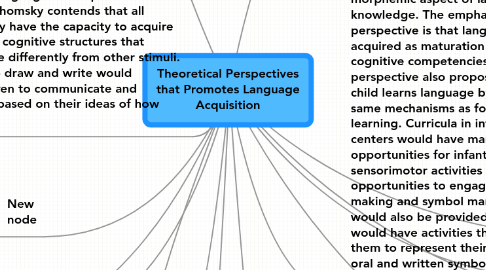Theoretical Perspectives that Promotes Language Acquisition
by Tyteasha Holden


1. Linguist Noam Chomsky is the theorist associated with the nativist perspective and it focuses on the syntactic aspect of language. The nativist perspective emphasizes inborn or innate human capabilities in nature, as being responsible for language development and Linguist Noam Chomsky contends that all people inherently have the capacity to acquire language due to cognitive structures that process language differently from other stimuli. Opportunities to draw and write would encourage children to communicate and create meaning based on their ideas of how language works.
1.1. Nativist Perspective
1.2. Action Point 2
2. Skinner Skinner is the theorist of the behaviorist perspective and it supports the syntactic aspect of language knowledge. The behaviorist perspective emphasizes the role of “nurture” and considers learning to occur based on the stimuli, responses, and reinforcements that occur in the environment (Otto, 2010, p.31). When teaching finger plays and action songs, the focus would be on using repetition, imitation, and positive reinforcement; a teacher's enthusiasm and praise for children's efforts in learning the finger play or action songs would provide further reinforcement.
2.1. Behaviorist Perspective
2.2. Medium Priority
2.3. Low Priority
3. New node
4. New node
5. New node
6. New node
7. New node
8. New node
9. Plan
9.1. Goals
9.1.1. Goal 1
9.1.2. Goal 2
9.2. Rules
9.2.1. Session Rule 1
9.2.2. Session Rule 2
